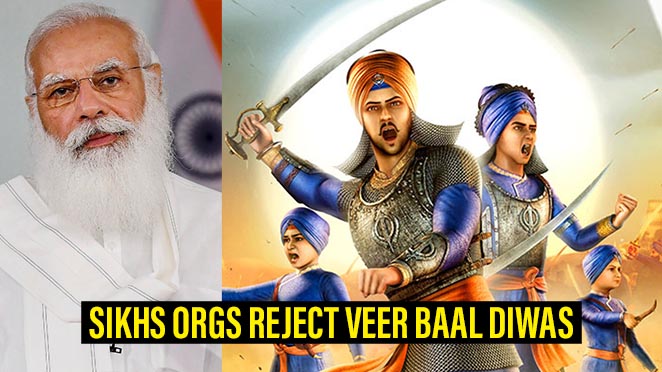
On 9 January, Prime Minister Narendra Modi made a big announcement on the 356th birth anniversary of Guru Gobind Singh Ji, the tenth guru of the Sikhs. He announced that every year 26 December will be celebrated as ‘Veer Baal Diwas’ in honour of the sacrifices made by the Sahibzadas, the four sons of Guru Gobind Singh Ji.
PM Modi, made the announcement through a tweet, said “Today, on the auspicious occasion of the Parkash Purab of Sri Guru Gobind Singh Ji, I am honoured to share that starting this year, 26th December shall be marked as ‘Veer Baal Diwas.’ This is a fitting tribute to the courage of the Sahibzades and their quest for justice.”
But few scholars and Sikh Authorities were not pleased with this move and rejected it. Further, according to the reports of The Print, The Shiromani Gurdwara Parbandhak Committee (SGPC), the apex body that regulates Sikh shrines, while welcoming Prime Minister Modi’s decision to observe 26 December as the Veer Baal Diwas, has expressed its reservations regarding the nomenclature of the day.
“We appreciate the sentiments of the Prime Minister, but connecting the martyrdom of the Sahibzadas to baal (child) is not fitting for their martyrdoms. In view of Sikh history, doctrines, and traditions, the incomparable sacrifices of the Sahibzadas of the Dasven Patshah (10th Guru) are like those of great warriors,” said SGPC president Harjinder Singh Dhami on Sunday (9 January).
ALSO READ | Sikh Gurmantar Allegedly Insulted By A Dutch Show, Ek Onkar Compared To Vulgar Line
He further said that “Sikh religion is based on certain principles, history and Gurbani. One should respect these principles. SGPC will appeal to the highest Sikh temple authority, Akal Takht Sahib, to give its formal approval to the proposed day.”
After this, Giani Harpreet Singh, Jathedar (head priest) of the Akal Takht, the highest temporal body of the Sikhs, reacted to the move and said that Sikh institutions should be consulted whenever such decisions are taken. “Not only are these institutions ready to impart this knowledge, they are duty bound to do so,” he said. Moreover, he added that while it was welcome that the Prime Minister wanted the history of the Sikh Sahibzadas to be taught in schools, limiting their martyrdom to a ‘Veer Baal Diwas’ was not acceptable.
Not only this, Scholars like Dr Dharam Singh, a former professor of Sikh studies and editor-in-chief of the Encyclopaedia of Sikhism, said that the issue of ‘Veer Baal Diwas’ has been going on for some time now. “It is apprehended that ‘Veer Baal Diwas’ will somehow be attached to the Rashtriya Bal Puraskar that the government of India gives every year. To compare the martyrdom of the Sahibzadas to an act of bravery by a child does not do any justice to them,” he said.
ALSO READ | Sikh Cab Driver Assaulted, US State Department Says, “Deeply Disturbed” By The Attack
“The words and the concepts used in the Sikh religion are to be understood in the context of their origin. For instance, Guru Tegh Bahadur (the ninth Guru) is called Dharam di Chadar because he gave up his life to fight for the right to freedom of religion. But to reduce his martyrdom to his having died to save the Hindu religion alone is wrong, though there is no doubt that the Hindus were the suffering community at that time. Similarly, the use of the words ‘veer baal’ for the Sahibzadas does not suffice.” he said.
“The children of the Gurus are referred to as Sahibzadas. And we refer to the four Sahibzadas of Guru Gobind Singh as Baba because what they did was not the act of a child but of somebody much older and more mature. It would have been better if the government of India had consulted some Sikh sources before taking this decision,” he added.
ALSO READ | What This Sikh Bus Driver Did After He Was Offered $100 Will Move Your Heart! Read To Know
Meanwhile, the move has been taken, as the sacrifice of the four Sahibzadas is considered a significant event in Sikh history. They achieved martyrdom during a conflict between the Khalsa, led by Guru Gobind Singh Ji, and a treaty of Mughal forces in 1704-05.
The incident took place during the last days of December, that is why every year in December, Sikhs mark these days with solemn prayers and the Shaheedi Jor Mela. It is a three-day annual gathering at Fatehgarh Sahib. Additionally, the Chaar Sahibzade (four sons of the Guru) and their martyrdom are also memorized as part of the Ardaas or daily prayer of the Sikhs.
This article is curated from The Print news website.




